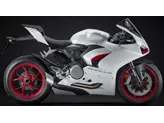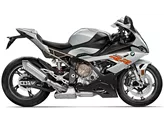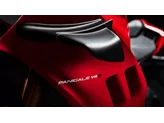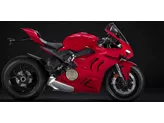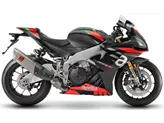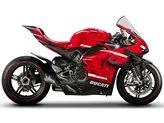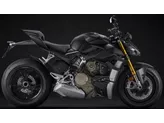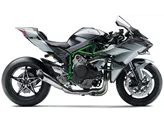Ducati Panigale V4 2018 vs. Yamaha R1M 2016

Ducati Panigale V4 2018

Yamaha R1M 2016
Overview - Ducati Panigale V4 2018 vs Yamaha R1M 2016
The Ducati Panigale V4 2018 and the Yamaha R1M 2016 are both high-performance supersport motorcycles that offer impressive features and capabilities.
Starting with the engine and drive train, the Ducati Panigale V4 2018 is equipped with a 1103cc engine that delivers a powerful 214 HP and 124 Nm of torque. It has a bore of 81 mm and a stroke of 53.5 mm, with a compression ratio of 14. The engine features four cylinders and four valves per cylinder, with desmodromic valve technology. On the other hand, the Yamaha R1M 2016 has a slightly smaller 998cc engine that produces 200 HP and 112.4 Nm of torque. It has a bore of 79 mm and a stroke of 50.9 mm, with a compression ratio of 13. Like the Panigale, it also has four cylinders and four valves per cylinder, but it uses DOHC valve technology.
In terms of suspension, both motorcycles feature upside-down telescopic forks in the front. The Ducati Panigale V4 2018 uses Showa suspension, while the Yamaha R1M 2016 is equipped with Öhlins suspension in both the front and rear.

Ducati Panigale V4 2018
When it comes to the chassis, both motorcycles have aluminum frames. However, the Ducati Panigale V4 2018 features a monocoque frame, which offers a more compact and lightweight design. On the other hand, the Yamaha R1M 2016 uses a Deltabox frame, which provides excellent rigidity and stability.
In terms of braking, both motorcycles have double disk brakes in the front.
When it comes to advanced rider assistance systems, the Ducati Panigale V4 2018 is equipped with ABS, while the Yamaha R1M 2016 offers additional features such as launch control, traction control, and anti-wheelie.

Yamaha R1M 2016
In terms of dimensions and weights, the Ducati Panigale V4 2018 has a front tire width of 120 mm and a rear tire width of 200 mm, with both tires having a diameter of 17 inches. It has a wheelbase of 1469 mm and a seat height of 830 mm. The kerb weight, including ABS, is 198 kg, and it has a fuel tank capacity of 16 liters. On the other hand, the Yamaha R1M 2016 has the same tire dimensions and wheelbase as the Panigale. However, it has a slightly higher seat height of 855 mm. The kerb weight, including ABS, is 200 kg, and it has a slightly larger fuel tank capacity of 17 liters.
In terms of strengths, the Ducati Panigale V4 2018 offers a powerful engine with great manners and a pleasant upper body position. It also has a sufficiently dimensioned chassis for country roads and a powerful yet not intrusive sound. Additionally, it provides good wind protection. On the other hand, the Yamaha R1M 2016 is praised for its lively handling, high-revving and precisely controllable engine, and excellent electronics package.
However, the Ducati Panigale V4 2018 does have some weaknesses. The seat can get warm, especially in city traffic, and the engine/clutch can feel a little rough in tight hairpin bends. On the other hand, the Yamaha R1M 2016 only offers a shift assistant for upshifting, which may be seen as a limitation compared to the Panigale.
Technical Specifications Ducati Panigale V4 2018 compared to Yamaha R1M 2016
Pros and Cons in comparison
Pros and Cons in comparison
Ducati Panigale V4 2018

The Panigale has become much more accessible in the 2018 V4 version than before. The engine, in combination with the electronics package, is still not as flawless and sterile as an inline four, but in practice it is a real blessing for Ducatisti - and a positive surprise for riders of other brands. The Panigale V4 also surprised with tolerable riding comfort on the country road and a pleasant level of stability. Progress here was clearly in the right direction. The new V4 is stronger and faster but also easier and more pleasant to ride.
Yamaha R1M 2016

Yamaha's high-tech rocket is still a technological leader in 2016. Radical, polarising and fascinating, it sets powerful lap times. It is closer to the race bikes than the other 1000s. In the meantime, no one is grumbling about the front.
Price Comparison Avarage Market Price Ducati Panigale V4 vs Yamaha R1M
There are a few key differences between a Ducati Panigale V4 2018 and a Yamaha R1M 2016. There are the same number of bikes of both models available on the 1000PS.de marketplace, specifically 5. It takes less time to sell a Yamaha R1M with 63 days compared to 91 days for the Ducati Panigale V4. Since model year 2018 1000PS.de editors have written 18 reviews for the Ducati Panigale V4 and 26 reviews for the Yamaha R1M since model year 2015. The first review for the Ducati Panigale V4 was published on 11/5/2017 and now has more than 131,500 views. This compares to more than 9,700 views for the first review on Yamaha R1M published on 12/3/2014.




